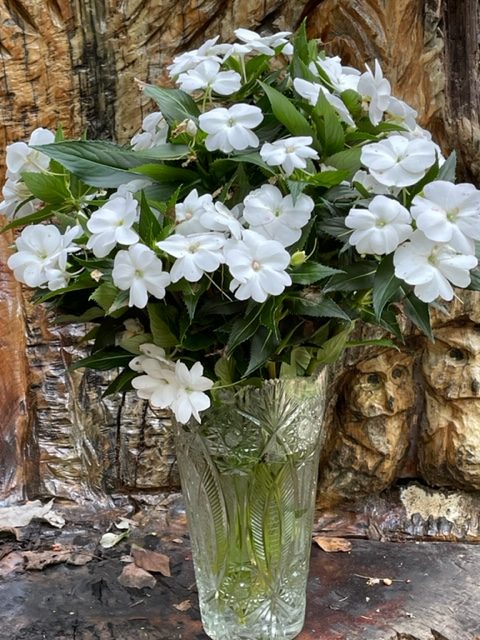Like bridesmaids at a bachelorette party, my “Sunpatiens” (impatiens bred to thrive in the sunshine) have been drinking non-stop all summer as Atlanta has been blessed with ample rainfall. These beauties drank it all in, acting as it there was no tomorrow and no reckoning at the end of the party.
Which is now. Rain stopped abruptly about 10 days ago and while most of my sturdy native plants are doing fine and adapting well, these big, blousy beauties are looking a little peaked, By late afternoon as the still-hot sun takes it’s toll they look a little hung over, with droopy leaves and wilted blooms.

I really have little sympathy for them. I don’t mean to sound judgmental, but there’s a price to pay for non -stop drinking. Though these days, without knowing when it will rain again or not knowing if the next rain will be a torrential downpour or a passing drizzle, who can blame them for making the most of every drop?
But that’s one of the challenges of gardening – and growing – in a world where the climate is changing and extreme temperatures and rainfall are becoming the norm.

I don’t mind helping out in the short term, sort of like providing a halfway house while they adapt to drying out. But long term? These annual plants are simply not worth pouring good, clean precious water over. They contribute little, except as eye-candy. They do not attract pollinators, do not provide food for caterpillars or songbirds, don’t make a good habitat for much of anything and don’t, as some plants do, put carbon back into the soil. In my garden, each plant has to earn its keep and serve a purpose in the ecosystem. And, since sunpatiens are annuals, I’ll have to pull them up in few weeks anyway to make room for cool season plants.

When I bought these new – fangled, sun – loving impatiens, I thought that they were about the healthiest looking plants I’d ever bought. Midsummer, I gave them a sprinkling of organic fertilizer and that, coupled with ample rainfall, resulted in plants that now stand more than three feet tall. So, it’s not their vigor or their beauty that I quarrel with, it’s the fact that they’re hanger-ons, requiring care, attention and lots of water without doing their share to create a healthy ecosystem.

The problem is, like a line of chorus girls, my sunpatiens create a gaudy border at the very front of my garden at the street. They set the stage for the rest of the garden and if they look wilted and unhappy it makes everything look neglected and sad. So, what to do? There’s no rain in the forecast, I don’t really want to waste water on them just to keep them alive for another couple of weeks but if I just dig them up, it will leave gaping holes in my front garden.
But, since I’m God in my own garden, I’m going to experiment. I’ve decided to cut back half of the stems with the hope that half the plant will need half the water, though I’m not sure that it works that way. But, it’s worth the experiment. One unexpected benefit of this was that I had armfuls of gorgeous white blossoms to bring indoors. I’d never considered impatiens as cut flowers before but they have lasted pretty well and look gorgeous in a vase.

The important lesson for me, as a gardener, is to think ahead and to work with my environment more than to control it. More and more I’m putting in plants that take fewer and fewer resources. And, I am restricting my palette to include only plants that provide something important for the ecosystem in which they live. I’m including more perennials than annuals, more shrubs and trees than grass. I’m working with the soil so that my plants produce good, strong roots, which will help them withstand the extreme challenges of a changing climate.
I really have nothing against chorus girls and bridesmaids, I just think it important to remember that when the party’s over, there’s work to be done.

Very clever. Don’t forget to update us as to whether half the stems require half the water.
I like the evolving theme of working with the environment, with every garden element having a job to do.